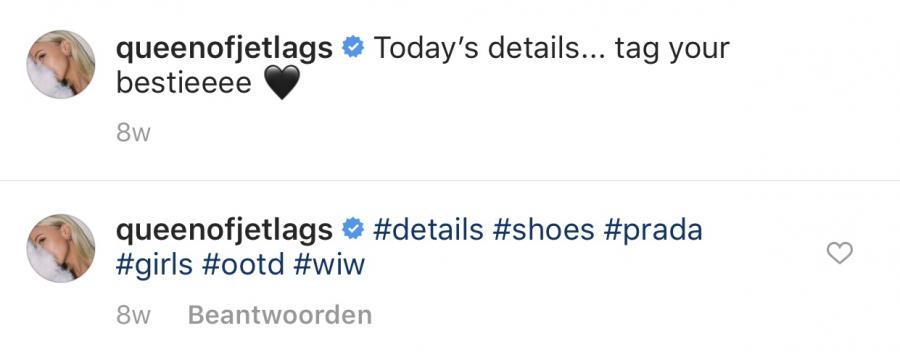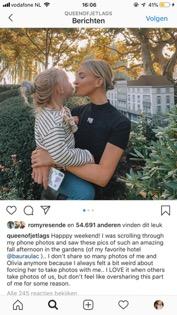
@Queenofjetlags constructing authenticity on Instagram
This article presents a deeper look into the Instagram account of @Queenofjetlags. As a social media influencer, @Queenofjetlags has her own way of constructing authenticity.
Looking at how @Queenofjetlags's booming Instagram account constructs authenticity can help us understand how her social media empire is built through this process. Why is @Queenofjetlags so successful on Instagram? An analysis of posts, reactions and comments by followers and fellow influencers suggests that perceived authenticity is crucial for influencers’ success.
Who is @Queenofjetlags?

Queen of Jetlags' office
Popular Instagram influencer, entrepreneur, blogger and vlogger Noor de Groot, also known as @Queenofjetlags, creates a fairytale online. Scrolling down to her very first Instagram posts, one can see that she started using Instagram in 2013, receiving only tens of likes. From then on, she started posting pictures of herself in her favorite outfits. Within one year, the Dutch influencer already had hundreds of likes per post. Her feed changed as well, from a rather messy, uncoordinated feed into a more matching, planned feed, as seen in the screenshots below.
An uncoordinated feed
...and a coordinated feed
With over the 700.000 followers and around the 20.000 likes per post currently, it seems that the 32-year old has created her own empire on Instagram within 7 years. Her account has followers from all over the world, mostly women. The captions under her pictures are in English, so that her global followers can understand them. @Queenofjetlags travels the world with her family, shooting content everywhere.
Besides Instagram, @Queenofjetlags also has a YouTube channel with 103.000 subscribers, where she also shares content. Notably, however, this account is in Dutch. As her global followers from Instagram are not able to understand her YouTube content, we can surmise that her YouTube channel is mostly based on her followers in the Netherlands.
Constructing authenticity
The first stage, or phase 1, of an influencer's career is focused on gaining as many followers as possible, and starting to promote brands through their popular accounts. The use of influencers’ accounts as advertisement platforms is partly due to a skepticism towards traditional advertisement (Braatz, 2017). It is believed that influencers can have more of an impact on users of social media compared to traditional ads. That means that influencers have to strive so that users of their platforms might be impressed with the way they promote products.
Then comes phase 2 for influencers, which is all about authenticity. In recent years, people have become more skeptical towards advertisements they see on social media too. ''Perceived 'authenticity' thus becomes valuable [for influencers], as it promotes credibility and likeability leading to increased visibility/popularity" (Gaden, 2014). People want to know about what they buy through reported real-life experiences instead of hearing about products through the lens of the perfect lives that are presented on social media.
When influencers’ content is constantly based on advertisements and promoting brands, it is hard for audiences to think that influencers are genuine.
Users of platforms also want to feel connected with influencers. People want to recognize their life in the advertisements they see. This is where influencers' "strategic authenticity" comes in of, which is all about making their life seem realistic and relatable. Something notable on @Queenofjetlags' account, for example, is that when she shares a picture of herself and her daughter, followers often reply with a heart emoji. This suggests that they feel some sort of connection with the influencer when she shares a picture that shows she loves her daughter besides living in a fairytale.
Reactions to a @Queenofjetlags post featuring her daughter
When influencers’ content is constantly based on advertisements and promoting brands, it is hard for audiences to think that influencers are genuine. Even though it is impossible to always be genuine when influencers are promoting products, the construction of a ‘strategic authenticity’ is very important. When users of platforms begin to view influencers as merely wanting to make money, there is no difference between their promotion and traditional advertisements anymore. This difference is key because the whole appeal of product promotion by influencers lies in that "instead of being skeptical of a commercial or social media ad, consumers are trusting that if their influencer of choice loves the product, they will too" (Matthew, 2018).
@Queenofjetlags' account consists of very diverse pictures, some very detailed: some posts are of herself, others are pictures of pretty skies, and others yet are about her family. The expensive brands she promotes may not be recognizable to all her followers, but the family part of her Instagram can be. In the picture below, posted on August 19, 2019, her clothes are all pink. Her pink outfit matches with her Fristi drink, and the caption reads ''Forever waiting and ready for all Sex and the City seasons to finally appear on Netflix, who is with me?!''. Her outfit now alludes to Sex and the City, and she thereby tries to bond with her followers through her taste in series. She tries to create a sense of togetherness by sharing her opinion on the fact that the series is not (yet) on Netflix.
Analysing @Queenofjetlags' Instagram
On Instagram, users have the possibility to tag and hashtag certain people or pages of, say, brands. Influencers can use these tag and hashtag features to bring a larger audience to people and brands, especially since these tags are clickable. @Queenofjetlags, for example, has a pattern to her way of promoting brands, judging from her most recent posts. When she posts personal, non-marketing posts, she has a clear caption without any tags. When she posts a commercialized post, she uses the tags and hashtags of the brand. Another noticeable habit she has is reacting hashtags and tags on her own pictures. This makes her account more clickable for users of the platform.

@Queenofjetlags adding hashtags in comments
Another important aspect of being an influencer is how people perceive you. The reactions found under @Queenofjetlags' posts are diverse, featuring followers from all over the world complimenting her about her posts. Commenters mostly react with a compliment and an emoji. Very positive reactions contain lots of emoijs and hearts. Sometimes followers will also tag each other under the influencers' posts.
The commenters' accounts range from people with hardly any followers to other influential people. @Queenofjetlags' fellow influencer friends include accounts like @Stephsa, @Annanooshin, @Clairerose and @Rianne.meijer, who are all Dutch as well. This practice of reacting to each others' posts can contribute to their strategic authenticity. By reacting to each other’s pictures, these other influencers gain visibility for their own account as well. This can be a tactic to make their accounts more "clickable", while also giving the impression that these people know each other in an everyday sense.
Comments by other Dutch influencers
Another notable characteristic of her comments sections is that @Queenofjetlags reacts to followers’ comments quite often. For followers, her reaction can give a more personal touch to following @Queenofjetlags. She mostly reacts to the first few people that leave a comment on a post, regardless of whether they have a big numberof followers or not. Sometimes she will also reply to comments posted later, but in these cases it is only to people with a bigger number of followers. @Queenofjetlags also likes a lot of her forllowers' reactions, which serves as a subtle hint that she notices her followers and reads their comments.
@Queenofjetlags reacting to followers' comments
Different influencer niches
The world of influencers includes different niches that target different sub-sections within a big market. One influencer can be famous for his/her workout videos, while another can be known for his/her travel videos, feminist stance, food blogs and so on.
Instagram is making it easy for people to search within particular niches. When you click on the Explore button, there are various options you can choose to refine your search, such as food, animals, TV and movies, travelling and style. Through this advanced search engine, Instagram is essentialy advertising niches. The platform is thus also tasked with defining what falls within a niche through selecting certain elements in posts.
Having a complex interaction and negotiation with people, groups and algorithms is important to being recognized as being part of a niche.
To make things easier, Instagram makes it possible for users to choose a specific niche to be part of. This niche is shown in the description/bio section of users' Instagram accounts. Choosing a niche is only possible when you make your account public and turn it into a "business account". There is an option for brands and businesses, and another for influencers, artists and public figures. When you choose to make a personal business account, there are different niches available to select from. However, truly being part of a certain niche within the bigger picture is only possible by working on creating an identity. Having a complex interaction and negotiation with people, groups and algorithms is important to being recognized as being part of a niche. Online identities are constructed through an interplay of interactions and algorithms.
According to Matthew (2018), "influencers must be trusted figures within a niche community and retain a loyal following". In order to appear as real individuals that followers can trust, it is important for influencers to show that they ascribe to certain commons norms and values. @Queenofjetlags has spoken about one particular subject she considers sensitive when it comes to sharing her life on Instagram. In the post pictured below, she shares her feelings about sharing pictures with her daughter. She admits it feels weird forcing her daughter to take pictures with her. This addresses a norm whereby she, as an influencer, has set a boundary, not to force her daughter to take photos for her content. She allows her daughter to be in her videos though, and it seems that her daughter likes being part of her videos on YouTube. In contrast to @Queenofjetlags, there are other influencers who base their profile on pictures of their children, ascribing to different norms on the matter.

@Queenofjetlags getting personal about content featuring her daughter
Brand marketing
Brand marketing through influencers' accounts is done in two ways. Brands can send free products to influencers and, if they like using the products, the influencers will share them with their many followers. Alternatively, companies pay influencers to share their products on their feed. In this case, influencers need to make their post their own, using their own language, operating within their niche-culture, and making their post as "authentic" as possible.
These two ways of brand marketing are thoroughly described by Braatz (2017), who also elaborates on "predesigns" that companies suggest. Companies make predesigns of what they expect from an influencer, determining hashtags to be used, what time their advertisement should be online, precise choice of words and so on. Some influencers have been caught just copying and pasting what the company composed. This can be taken to suggest that the influencer was not using this product at all, which can compromise followers' trust.
The uncovering of influencers copying and pasting constructed advertisements has lead to more transparency in promotional posts. The UK was one of the first countries to set a regulatory framework to protect users of social media in the new world of advertisements. Influencers must add #ad or #collab when they are promoting a product, for users/followers to be able to recognize the post as an advertisement. The relevant rules in the Netherlands, which followed after the UK, are very similar.
Just like any other influencer, @Queenofjetlags uses the affordances of Instagram to promote products. Through recognizable tags and hashtags, the brand becomes more clickable. This makes it easy for people to visit the actual page of the brand or product she is advertising. In her promotional posts, her caption is usually a simple text with a tag and a hashtag. In her non-promotional posts, @Queenofjetlags again uses just short simple captions, usually with no tags or hashtags, as seen below. So regardless if it is a promotional post or not, she relies on short and powerful captions, the only difference being the use of tags and hashtags. @Queenofjetlags thus creates a sense of trust: she does not fundamentally change her posts if they have promotional purposes, and thereby her followers still recognize her own personal touch in these posts.
Tags and hashtags on promotional posts
Non-promotional posts without tags and hashtags
To conclude
Zooming in on the account of @Queenofjetlags, we've been able to analyse strategic authenticity. Through various strategies, such as making the effort of liking and reacting to comments, @Queenofjetlags cultivates a sense of connectedness with her followers. Further, Instagram makes it possible for influencers to be part of a niche, thus making it easier for them to promote products targetting audiences more accurately. Influencers have to adapt to the second influential era, where perceived authenticity is key.
References
Audrezet, A., de Kerviler, G., & Moulard, J. G. (2018, July 8). Authenticity under threat: When social media influencers need to go beyond self-presentation. Retrieved November 4, 2019.
Becker, H. (1963). Outsiders. New York: The free press.
Braatz, L. A. (2017). #Influencer marketing on Instagram.
Elmhirst, S. (2019, April 19). ‘It’s genuine, you know?’: why the online influencer industry is going ‘authentic.’ Retrieved November 1, 2019,
Gaden, G. (2014). The ‘real deal’: Strategic authenticity, politics and social media. First Monday. Retrieved October 25, 2019
GOV. UK. (2019, April 8). UK to introduce world first online safety laws. Retrieved November 15, 2019.
Hauptmann, J. L. (2019, August). Influencer authenticity: Can you trust anyone with your brand? Retrieved November 1, 2019,
Maly, I., & Varis, P. (2015). The 21st-century hipster: on micro-populations in times of superdiversity. European Journal of Cultural Studies, 1–17.
Matthew, J. (2018, July 30). Understanding Influencer Marketing And Why It Is So Effective. Retrieved November 4, 2019,
Reclamecode. (2019). Reclamecode social media & influencermarketing. Retrieved November 15, 2019.
West, T. (n.d.). Credibility, trust and authenticity in influencer marketing. Retrieved November 1, 2019.